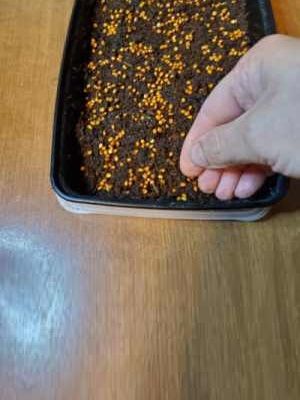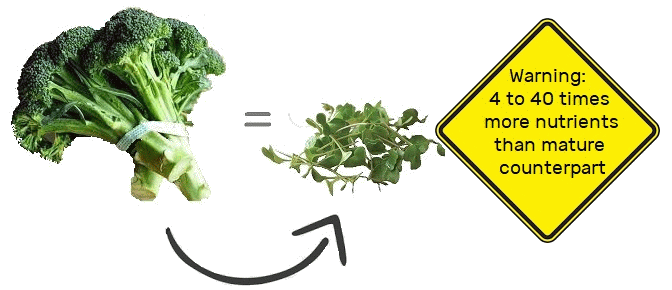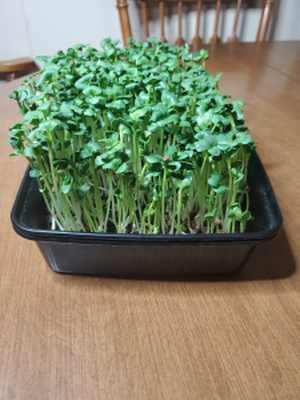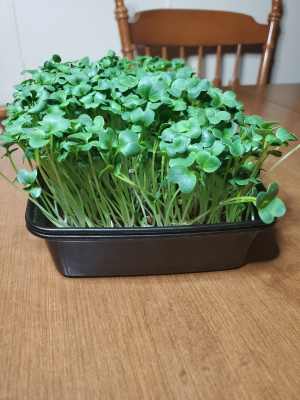
Day 0 - Radish Seeds planted.
The Most Nutritional Dense Food on Earth!
Grow your own Microgreens - one of the most nutritionally dense foods, gram-per-gram, packed with loads of flavor. Microgreens are baby plants - Picture all the nutrients in a full grown plant packed down into the most nutrient dense form possible into a little Microgreen. One of the healthiest things you can eat. They are Quick, Easy and Fun to grow. I have grown them with my young grandchildren, my daughter and my neighbor. The Microgreens develop so quickly, as little as 6 days from seed to harvest, that it is exciting to head to school/work in the morning and find them 1 inch taller when you return. 
Sprouts are the infant stem that comes from the seed and doesn't see the light. Microgreens are the next plant stage, between the Cotyledon leaf & true leaf (the 2nd set of leaves) stage. They are much more nutritious as when the plant is exposed to the light, a chemical reaction occurs that produces many more vitamins and nutrients. Bok Choy Cabbage Microgreens are ranked #2 for the most nutritionally dense crop. One cup has Vit A (63% of DV), Vit C (52% of DV), Vit K (40% of DV), Folate (12% of DV), Calcium (7% of DV), Vitamin B6 (7% of DV). Rich in minerals and chlorophyll. It has more Vit C than an orange and 3 times the Vit C of Cilantro. All Microgreens are extremely high in nutrients. The top 5 cancer fighting Microgreens are #1 Broccoli (Kale, Cabbage) - contains sulforaphane,
#2 - Chickpea (Peas, Soybean) - contains isoflavones, #3 Rutabaga - very high antioxidants, #4 Flax - induces cancer cell death, and #5 Buckwheat - inhibits cancer cell effect.
 12 in 1 MICROGREEN KIT
12 in 1 MICROGREEN KIT All you need to grow 12 of the most popular Microgreens. Includes soil, seeds, 2 trays, humidity domes, spray bottle, Microgreen Grow Guide for each seed type, a Microgreen Troubleshooting Guide & 144 Microgreen Recipes. Supplies for a total of 12 large crops of Microgreens: Arugula, Kale, Radish, Broccoli, Cabbage, Peas, Beets, Sunflower, Wheatgrass, Basil, Mustard, and Cilantro Microgreens.
$89.99 $72.38

The 12 types of Microgreens included in the MyGrow Microgreen Kit listed from easiest to most challenging to grow:
#1 - Kale Microgreens - Have a mild kale flavor. Very easy to grow.
#2 - Arugula Microgreens - Have a peppery Arugula flavor. Great for making a Pesto for your steak.
#3 - Mustard Microgreens - This one of the milder Mustard Microgreen seeds. Very easy to grow.
#4 - Radish Microgreens - Tastes exactly like a Radish. If you like Radish, you will love munching on these.
#5 - Cabbage Microgreens - A mild cabbage flavor. A bit sensitive to being over watered.
#6 - Broccoli Microgreens - Tastes just like broccoli. Very sensitive to being over watered.
#7 - Peas Microgreens - A fun one for children to grow. Has an additional growing step. Tastes just like peas.
#8 - Sunflower Microgreens - Popular for children. Crunchy with a nutty flavor. Eat like a chip.
#9- Basil Microgreens - Slow growing. Tastes just like Basil.
#10 - Wheatgrass Microgreens - Be very careful not to over water. Lots of nutrients. Great for juicing.
#11 - Cilantro Microgreens - Very slow to germinate and slow growing
#12 - Beet Microgreens - Sensitive to "Dampening Off". Taste like beets.

Day 0 - Radish Seeds planted.

Day 2 - Sprouting. Grown in the dark.

Day 3 - Sprouted 5cm - Ready for the Light.

Day 4 - First Day Grown in the Light

Day 5 - Second Day Grown in Light

Day 6 - Ready for Harvest.
There are over 100 kinds of Microgreens to grow. Some require additional grow steps and some are harder to grow than others. Some of the Microgreens that are easy to grow are Arugula, Broccoli, Cabbage, Kale, Mustard, and Radish Microgreens. Some of that require extra steps are: Beets, Cilantro, Peas, and Sunflower. Here is a general overview of the grow steps:
Though not technically true, picture all the nutrients in a head of broccoli condensed down to being contained in the little Microgreen plant. The nutrients are much higher in Microgreens than other plants in nature.
Arugula Microgreens are a natural super-food. They contain Folate, Iron, Copper and other minerals. High in Vitamin A, C and K.
Basil Microgreens - A half cup of Basil contains Vitamin K (98% of DV), Manganese (10% of DV), Copper (9% of DV), Vitamin A (6% of DV), Vitamin C (5% of DV), Calcium (4% of DV), Folate (4% of DV), Iron (4% of DV), Omega 3 fats (3% of DV) and Magnesium (3% of DV).
Beet Microgreens - Beet Greens are ranked #4 for the most nutritionally dense crop. One cup of beet greens contain 8.4 calories, Vit K (190% off DV), Vit A (48% of DV), Vit C (19% of DV), Potassium (8% of DV), Magnesium (7% of DV), Manganese (7% of DV), and Iron (5% of DV). Contains pectin the helps remove heavy metals from body.
Broccoli Microgreens - Broccoli is ranked #12 in the most nutritionally dense crop. One cup contains Vit C (135% of DV), Vit K (116% of DV), Vit A (11% of DV), Folate (14% of DV), Vit B6 (8% of DV), and Potassium (8% of DV). Also contain minerals, enzymes, 35% protein and chlorophyll. Helps stimulate the immune system and has a tonic effect.
Cabbage - Pak Choi Cabbage is ranked #2 for the most nutritionally dense crop. One cup has Vit A (63% of DV), Vit C (52% of DV), Vit K (40% of DV), Folate (12% of DV), Calcium (7% of DV), Vitamin B6 (7% of DV). Rich in minerals and chlorophyll. It has more Vit C than an orange and 3 times the Vit C of Cilantro.
Cilantro - Cilantro Microgreens have high vitamin A, C, E, K, calcium, iron, phosphorus, potassium, magnesium, phytonutrients, flavonoids, and phenolic compounds.
Kale - Kale ranks #10 in the most nutritionally dense crop. One cup of Kale contains33 calories, Vitamin K (684% of DV), Vitamin A (206% of DV), Vitamin C (134% of DV), Vitamin B6 (9% of DV), Manganese (26% of DV), Copper (10% of DV), Calcium (9% of DV), and Potassium (9% of DV). Also contains antioxidants, lutein, quercetin, kaempferol, and zeaxanthin.
Mustard MicrogreensOne cup contains Vit K (181% of DV), Vit A (56% of DV), Folate (15% of DV), Vit C (14% of DV), Manganese (13% of DV), Magnesium (6% of DV) and Iron (5% of DV). (ref: Natural Living Ideas).
Radish Microgreens - Radishes are know as an energy food. One cup contains Vit C (29% of DV), Folate (7% of DV), Vit B6 (4% of DV), Riboflavin (3% of DV), Vit K (2% of DV), Calcium (3% of DV), Magnesium (3% of DV), Potassium (8% of DV), Manganese (3% of DV) and Copper (3% of DV). The leaves have 10 times more Vit C than the root.
Peas Microgreens -- Contains Vit A, Vit B, Vit C, Vit E and Vit K as well as 38 minerals including Folic acid, thiamine, riboflavin, calcium, iron, magnesium, niacin, phosphorus, potassium and chlorophyll. Contains all essential Amino Acids and have 26% of the DV Protein.
Sunflower Microgreens - They are a great source of protein and an excellent source of vitamins A, B6, D, E and K. They also contain calcium, iron, magnesium, potassium, niacin, phosphorus, and dietary fiber.
Wheatgrass Microgreens -- Wheatgrass consists of 70% chlorophyll (dramatically alkalizes your body) and 30% vitamins and 92 trace minerals including potassium, fiber, iron, selenium, and Vitamins A, C, E & K.
Grow Mediums - There are many mediums that you could use for growing Microgreens. Experiment with different soil types until you find one that works best for all the kinds of Microgreens that you want to grow. The Jiffy & Coco Coir soil included in the MyGrow Microgreen kits will successfully grow all the common types of Microgreens. It is important that your grow medium is pH balanced with a proper balance of nutrients (Nitrogen, Potassium & Phosphorus). I once bought an organic soil (expensive and high quality) that had a higher nitrogen content than other soils. It worked great for Sunflower Microgreens (they prefer higher nitrogen) but caused the other types of Microgreens to grow so poorly that the crop was discarded. Cabbage and cauliflower Microgreens prefer higher Potassium. Salad Microgreens prefer higher Phosphorus.
Many growers mix their own soil. For example it might be 60% Peat Moss, 30% Coco Coir, and 10% Pertile or Vermiculate. Other Growers buy premixed soil. Every grower has their own opinion about what is best. Experiment and find what works for you.
Soil - Soil is one of the most popular growing mediums and is readily available. It works for all Microgreens. Some soils will work much better than others - you need a good balance of Nitrogen, Potassium and Phosphorus. When planting Microgreens soil depth should be 1/2" to 1".
Compost - Compost can be an additive to your soil. Usually it is high in nutrients. If sterilizing your soil/compost is necessary, do so by baking it at 180F for 30 min or put the damp soil in a 4" layer between two plastic sheets out in the hot sun for four days.
Coco Coir - Coco Coir is made from the outer fiber of coconuts - extracts from the husks. Coir can be bought in mat form or as loose soil. It is very water absorbent and provides good aeration (air) for the plants. It does not have a nutritional content.
Perlite - Perlite is volacanic glass expanded to 13x its normal size. As a soil additive, it helps prevent water loss and soil compaction. It is well balanced with a pH of 7.
Peat Moss - Peat moss comes from peat bogs and helps maintain moisture content.
Vemiculite - Vermiculite is a mica mineral expanded in size. It is light weight and increases aeration (air) & moisture retention. It is pH neutral and mold resistant.
Vermicast - Vermicast or worm castings are earthworm waste. They are often used as a soil additive.
Rock Wool- Rock Wool is a fiber made from basalt, coke & limestone. It is frequently used in green houses and maintains moisture.
Epson Salt - Epson Salt is a soil additive. It is high in magnesium. Magnesium enables plants to absorb the nutrients from the soil.
Coffee Grounds- Coffee grounds are slightly acidic when added to soil. They are known for their buffering capacity. If soil is acidic or alkaline, it will bring the pH back to neutral. They have a high moisture holding ability and are high in Nitrogen.
Burlap - Burlap mats can be used to grow the Microgreens hydroponically. They do not have any mineral contents so fertilizer may be needed. Wheatgrass and Pea Microgreens grow well on Burlap.
Hemp - Hemp mats are made from from Hemp fiber. Though more expensive they have excellent water & air retention for growing the Microgreens. Broccoli and Kale Microgreens grow well on hemp mats.
Biostrate - Biostrate is a manufactured felt used when growing hydroponics. It is pH balanced but doesn't have good water retention.
Screen - A finely meshed Screen can grow Microgreen hydroponically. The screens are also re-usable.
NOTE: - Some studies have been down that show E.coli, Listeria and Salmonella survive at a higher rate on a grow mat than on soil. See the following link for more details" https://sciworthy.com/disease-causing-bacteria-can-grow-on-hydroponic-microgreen-mats/. Because of this, I grow all my Microgreens on soil and only include soil in the MyGrow Microgreen grow kits.
There is a relationship between the type of soil and air temperature. They affect each other. For example sandy soil will heat up faster. If growing outdoors, in the early spring the soil temperature is less by 1 to 10F than the air temperature. In the summer, the soil temperature is higher by 10 to 40F than the air temperature. In the winter (an insulator) the soil temperature is usually higher than the air temperature.
The amount of Air in the soil is crucial. Plants uptake air and water through their roots. They absorb the oxygen and give off carbon dioxide.
Can soil be re-used? If you re-use the soil immediately for another crop (even if you try to pick out the roots) you will have mold and rot issues. It takes 20-40 days for the old roots to break down. You can add an enzyme to help speed up this process such as Hygrozyme Enzyme Formula or Cannazym by Canna. In the USA if you are selling the Microgreens, you can not re-use the soil unless you have it professionally composted and records to prove so.
How much water is enough water for the Microgreens?At different stages of the Microgreens growth they need different amounts of water. Different seasons and different humility levels require different amounts of water. Learn to judge how much water is needed by looking at the soil or by the weight of the tray. The soil should be wet but not puddle even when pressed.
When the Microgreens (larger seeds only) have weight applied to them, do not water them. The soil is already moist from when they were planted.
When under the blackout dome, Microgreens prefer to be thoroughly misted with water every morning and night. When growing under the light, Microgreen prefer to be bottom watered - pour water between the planting tray (has holes) and the bottom tray.
Water with water that is the same temperature as the soil (usually 65-78ºF). Plants do not like rapid temperature changes.
General Rules to Go By:
1. For larger seeds, apply weight for a minimum of 24 hours after germination.
2. Keep the Microgreens under the blackout dome until a minimum of 48 hours after the first Cotyledon leaves or until they have reached their desired height.
3. Harvest the Microgreens just before the second set of leaves come out. An exception to this is Mustard, Fennel, Basil & Cilantro Microgreens. These can be grown longer. Harvest either in the early morning or late evening when it is cooler. Warmer temperatures will cause the Microgreens to wilt quickly after being harvested.
The Microgreens are not growing - Something in the plant environment is not correct. Is there 35-50% humidity, a room temperature of 65-75ºF, enough water, or enough light? Most Microgreens will still grow at cooler temperatures but at a much slower rate. They will also grow at warmer temperatures or higher humidity but then are more likely to mold.
Is the pH of your water correct? Microgreens prefer a pH of 5.5 to 6.5 where 6.0 is best. Test the water using a pH strip. The pH of your water can be changed by adding baking soda (increases pH) or white vinegar (decreases pH) to the water. Filter your water, or leave sitting out at room temperature for 48 hours, to remove any chlorine from your water.
Plants absorb more nutrients (water) when the water in their leaves evaporate. Better air circulation (a fan blowing) means a better evaporation rate & more nutrient absorption.
White mold is growing on the soil surface - Roots hairs may look like mold. The root hairs will be coming out from the root thread. Mold will look like a spider’s web. Mold is caused by the soil being too wet, too high of a humidity, too warm of a temperature, or not enough air circulation.
To treat the mold, spray the surface with water mixed with 1 Tbsp of 3% Hydrogen Peroxide. Put a fan nearby to improve the air circulation.
Other types of mold like Botrytis when planting larger seeds is caused by the seeds not being sanitized or by a residue that is left on the seeds after they are soaked. To sanitize the larger seeds, soak the seeds in vinegar+water, or hydrogen peroxide+water for 20 minutes. After sanitizing or soaking seeds, give the seeds a thorough rinse.
What type of soil is best? - Professional growers often mix their own soil or grow mats. A common soil combination is Peat Moss (60%), Coco Coir(30%), and Perlite/Vermiculite/ Compost (10%). Some studies** show a higher rate of Salmonella & Listeria on grow mats and that soil is the healthiest & safest option. **https://sciworthy.com/disease-causing-bacteria-can-grow-on-hydroponic-microgreen-mats/.
Uneven growth - Uneven growth is caused by uneven seed distribution when planting or uneven watering. The edges of the soil dry out quicker than the center.
Yellow leggy Microgreens - This is a normal when the Microgreens are in the blackout dome. The Microgreens will quickly turn green when put under the light.
The Microgreens are laying down - The soil is either too dry, too wet, or the water's pH is off. If they are growing along the ground instead of upright, they were not taken out of the weight or blackout dome soon enough.
Microgreens Taste Bitter - Different Microgreens taste best at different points of their growth. Overall, they taste best just prior to the growth of the second set of leaves (the first set of leaves are Cotyledon leaves). The longer the plants grow, the more bitter they will taste.
What is the best way to store the Microgreens after they are harvested? - The best way to store the Microgreens is in an air tight container in the refrigerator. If you will be taking them from the refrigerator to a Farmers Market, put a dry paper towel in the bottom of the containers to collect condensation. To keep the Microgreens longer in a refrigerator & prevent them from drying out, put a moist paper towel in the bottom of the containers.
We love our customers!
Questions? Drop a note.
Eau Claire, WI, US
Phone: 715-456-7222
Email: MyGrowMicrogreens@gmail.com